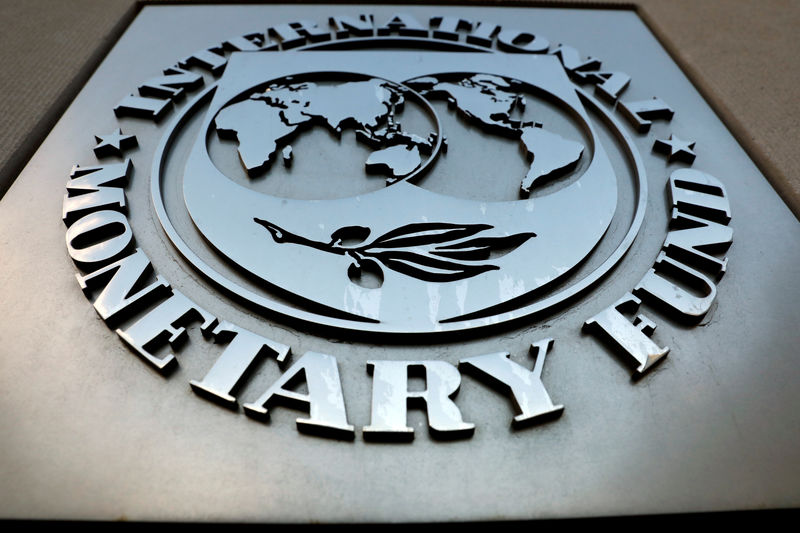By David Lawder and Andrea Shalal
WASHINGTON (Reuters) - The U.S.-China trade war will cut 2019 global growth to its slowest pace since the 2008-2009 financial crisis, the International Monetary Fund warned on Tuesday, but said output would rebound if their dueling tariffs were removed.
The IMF said its latest World Economic Outlook projections https://www.imf.org/en/Publications/WEO show 2019 GDP growth at 3.0%, down from 3.2% in a July forecast, largely due to increasing fallout from global trade friction.
The forecasts set a gloomy backdrop for the IMF and World Bank annual meetings this week in Washington, the first for the Fund's new managing director, Kristalina Georgieva. She is inheriting a range of problems, from stagnating trade to unrest in Ecuador and political backlash in Argentina over IMF-mandated austerity programs.
Without a nearly simultaneous easing of monetary policy by major central banks, IMF chief economist Gita Gopinath said global growth would be half a percentage point lower in 2019 -- at 2.5%, teetering on the edge of widespread recession.
"The weakness in growth is driven by a sharp deterioration in manufacturing activity and global trade, with higher tariffs and prolonged trade policy uncertainty damaging investment and demand for capital goods," Gopinath said.
The global crisis lender said that by 2020, announced tariffs would reduce global economic output by 0.8%. That translates to a loss of about $700 billion -- the equivalent of making Switzerland's economy disappear.
The growth downgrade assumes that all announced U.S. tariffs on Chinese goods are put in place, along with Chinese retaliation. These include a 5 percentage point U.S. duty increase on Chinese goods originally scheduled for Tuesday and 10% tariffs on $156 billion in Chinese goods scheduled for Dec. 15.
If these incremental moves are scrapped completely by a U.S.-China trade deal, the global GDP loss would shrink to 0.6%, Gopinath said. She added that all output would rebound by 0.8% if all U.S. and Chinese tariffs were removed.
Services were still strong across much of the world, but there were some signs of softening in that sector in the United States and Europe, the IMF said.
For 2020, the Fund said global growth was set to pick up to 3.4% due to expectations of better performances in Brazil, Mexico, Russia, Saudi Arabia and Turkey. But this forecast was a tenth of a point lower than in July and was vulnerable to downside risks, including worse trade tensions, Brexit-related disruptions and an abrupt aversion to risk in financial markets.
If Britain were to leave the European Union with no customs deal in place, it would cut Britain's GDP output level by as much as 5% in the next two years and 3% in the longer term, Gopinath said.
INVESTMENT, TRADE STALL
The World Economic Outlook report spells out in sharp detail the economic difficulties caused by the U.S.-China tariffs, including direct costs, market turmoil, reduced investment and lower productivity due to supply chain disruptions.
The IMF said foreign direct investment abroad by advanced economies came to "a virtual standstill" in 2018 after increasing in earlier years to average more than 3% of global gross domestic product annually - or more than $1.8 trillion.
The institution said the decline of some $1.5 trillion between 2017 and 2018 reflected purely financial operations by large multinational corporations, including in response to changes in U.S. tax law.
Global vehicle purchases fell by 3% in 2018, reflecting a drop in demand in China after expiration of tax incentives and production adjustments after adoption of new emissions standards in Germany and other eurozone countries.
Global trade growth reached just 1% in the first half of 2019, the weakest level since 2012, weighed down by higher tariffs and prolonged uncertainty about trade policies, as well as a slump in the automobile industry.
After expanding by 3.6% in 2018, the IMF now projects global trade volume will increase just 1.1% in 2019, 1.4 percentage points less than it forecast in July and 2.3 percentage points less than forecast in April.
Trade growth was expected to rebound to 3.2% in 2020, however risks remained "skewed to the downside," the IMF said, with a significant drag on both the U.S. and Chinese economies.
TARIFF, RESHORING LOSSES
New IMF projections show China's GDP output falling 2% in the near term under the current tariff scenario and 1% in the long term, while U.S. output would decline 0.6% over both time spans.
"To rejuvenate growth policymakers must undo the trade barriers put in place with durable agreements, rein in geopolitical tensions and reduce domestic policy uncertainty," Gopinath said.
But she was cautious about U.S. President Donald Trump's announcement on Friday about the first phase of a U.S. trade deal with China, saying that more details were needed about the "tentative" deal.
The IMF also modeled what would happen if multinational firms in the United States, euro area and Japan reshored enough production to reduce nominal imports by 10%. The lender found that it would drive up consumer prices and reduce domestic demand, while throttling the spread of technology to emerging economies.

"At 3% growth, there is no room for policy mistakes and an urgent need for policymakers to cooperatively deescalate trade and geopolitical tensions," it said. "Further escalation of trade tensions and associated increases in policy uncertainty could weaken growth relative to the baseline projection."